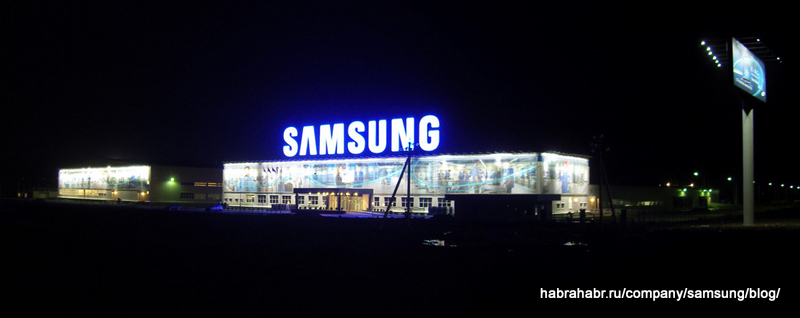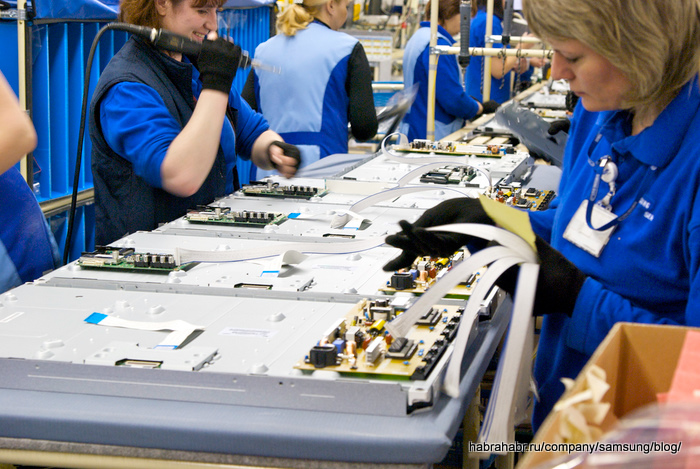Photo report about the visit of SERK (Samsung Electronics RUS Kaluga)

Preamble
On February 26, 2010, I, habrappo dorofej, and about thirty other bloggers and journalists, among whom were representatives of television from Ukraine, Kazakhstan, and our own TV channel “TV-Center” (“Sreda” program), were invited to visit SERK (Samsung Electromics RUS Kaluga), plant for the production of televisions and monitors for the Russian market and CIS countries.
At the moment, SERK occupies one of the first places in the overall standings among Samsung factories in terms of production and other indicators. As we were told during the excursion, this is partly due to the fact that the plant was built recently and, as a result, equipped with the latest technology, but basically this is of course the merit of the workers themselves.
')
Little about construction
This is how the plant looked like on July 1 :)

The construction of the plant was also engaged in the Samsung unit. All the work was completed in almost a year. The next photo is January 7, 2008. Judging by the pace of construction, the longest in it is the preparation of the foundation:

And on October 17, 2008, the plant looked as in the title picture.
Tour start
After we drove into the factory, we were dropped off the bus and asked to wait for our escort, Oleg Sudakov:

A few minutes later he came up and the tour began. The first thing we saw in the factory - the lobby:

In the next two photos you can find two very well-known bloggers-photographers (one of them, especially on the head of hair :). I unfortunately cannot provide links to their accounts in lj, since the material posted there does not somewhat comply with the Samsung security policy.



To tell you the truth, I was a little surprised - the situation around looked more like a reception at the office of a large company than a factory checkpoint. Later, everything fell into place - high-ranking guests often come to the plant, and therefore the face of the plant, like everything else, should look decent for the company. So far, some organizational issues have been resolved, we had the opportunity to photograph the situation, as well as evaluate the quality of new technologies - “LED” (this is a marketing name, it will be a little lower) and Blu-Ray. I am not ashamed to repeat the words of Oleg - I can not see such quality of the picture anywhere else for a long time. The combination of these two technologies really leaves an indelible impression, my feelings could well be described by the newfangled expression “wow-impulse”.
PS: the paragraph was corrected after discussion in the comments.
Presentation of the products of the plant
Let's return to the tour. As soon as all organizational issues were resolved, we were asked to proceed to the plant's conference room:



At the demonstration stand, two types of monitors were presented unassembled - LED and conventional LCDs:











I will not go into the details of both technologies, since the post as a whole is not about that, I will only note a few of the main differences between “LED” and LCD:
- Smaller dimensions, due to the fact that the backlight is not located at the bottom but on the sides (and is not based on lamps, but on LEDs)
- Better picture, due to more even illumination and technology features
- Less harmful to the environment because mercury is not used
- Less demanding process technology
After we were given to photograph the panels, turned on the light and told a few facts about the plant itself:
- The number of staff is about 1300 people
- It was opened on September 4, 2008
- Launches the goods under the mark "Made in Russia" (more on this below)
- About 150 models changed a year - that is, an average of three models appeared per week
- Practically all workers have higher education. The conversation, of course, was not about warehouse workers and other specialties that do not require serious professional skills.
Also, laudatory speeches were made to the management of the company, and other, little interesting information to Habra :)
As for “Made in Russia”, this is a very important point, and this is why: firstly, it significantly reduces the final cost for the consumer (both in Russia and in the CIS countries), secondly, keep in mind - almost everything The company's monitors for our market are currently produced at this plant, which means that if you see a manufacturer in another country in a store in the country column, this is most likely a stale product.
Product assembly line
After listening to the introductory information, we went back to the first floor (the conference room was located on the second floor). There, special radio receivers were distributed to us, with the help of which we could hear Oleg regardless of his location and he finally went to work. I will say right away - the most interesting, the production process of the boards - we were forbidden to take pictures. Someone of course made a couple of shots "from under the floor", but personally I didn’t stoop to such disrespect. After the group passed the "holy of holies", we got on the final assembly line. I apologize in advance for some cropped frames, it was forbidden to photograph into the distance (although the reasons for this remained unclear):
Not the most successful picture of the entire line:

The very beginning of the line, here bring all the components:

Here they begin to install on the "frame" of the TV:





Next, the girls check the almost finished equipment for performance:

After that, it is packed and ... Then I and I were distracted by Oleg's story about the logistic features of production and unfortunately forgot to take pictures of the final process of packing equipment into boxes. But believe me, there was nothing interesting there, except for charming packers;)
But in the same assembly shop, the tracks for the passage of the robot, it performs the simplest function “bring, serve, charge, don't interfere” :)
Why is the line virtually unattended? It was decided that for such a huge number of models of manufactured products it would be cheaper to use human labor than to automate and later maintain the entire assembly process.

Unfortunately, when we passed this site, the robot was “sleeping”. It should be noted that Oleg constantly tried to simplify his speech to a minimum, was somewhat absurdly joking and generally tried to entertain us in every way. As I understand it, this affects the experience of working with high-ranking guests, a lot of officials come to the plant, from mayors of neighboring cities to various ministers. So there’s nothing to blame for our escort, on the contrary, it was obvious that he is trying in every way to help us in his work. I just don’t quite know how :) After the tour, I asked him how often they had such events. Oleg replied that it was extremely rare, usually after all the state came. officials. Today, for example, when I write this post, it is such a day.
Warehouses
Then we were taken to the warehouse, where almost all the parts for the production of manufactured products are stored. Particularly noted was the fact that such four-storey racks can significantly reduce the storage space. In general, this is an innovation among similar plants.

Part of our group is listening to Oleg:

Workshop for the production of plastic parts

In general, the process of obscenely simple. Raw material arrives:

These are certain granules, they are filled up into such things in the process of preparation for production:

and after that, in the already liquid state, the raw material enters one of these machines:

At the exit, we have a finished part, on average in 90 seconds:

The data shop is fully automated, of the people working here only attendants:


A similar light bulb is installed on every machine and every production unit. The functionality is clear - when the color changes, the worker must react to the problem. It goes without saying that no siren whines. Although we were asked to remove these lamps only in the "green" state :)

Machines vary in the number of working tons in the press. Here are the idle and ready-to-use molds:

After crimping parts in the channels through which raw materials are delivered, production waste remains - some sticks similar to coat hanger. They are subsequently used again for the manufacture of some parts or for resale.
Quality control line



Finished parts are checked for all sorts of defects, and then sent to the warehouse, and from there they already fall on the assembly line.
Conclusion
Well, that's probably all. Only a few photos left. Dress code:








Here we saw such a monument in Narofominsk, opposite the restaurant where we had dinner after the trip:

Acknowledgments
Oleg Sudakov for his quality work.
Ilya aka dorofej and Ivan aka cote_de_geneve for cooperation in our difficult task.
Andrey Bodunov for the camera provided at the last moment.
All commenting for practical comments.
Links
3DNews: LED TV technology - how it works
3DNews: Samsung LED TVs: from Kaluga with love
PS: I apologize wildly for the quality of the photos - we are new to this for the time being :) But we paid more attention to verbal information, which means we made the post a little more interesting.
PPS: for the found in the text orthographic, logical, and other errors, please write in inbox.
UPD: The moment with the confusion of “plasma” and “LED” is clarified - TVs and monitors with a pdp-matrix are actually manufactured at the factory (correctly called “panel” by the way), therefore their mention in press releases is justified.
Source: https://habr.com/ru/post/86471/
All Articles